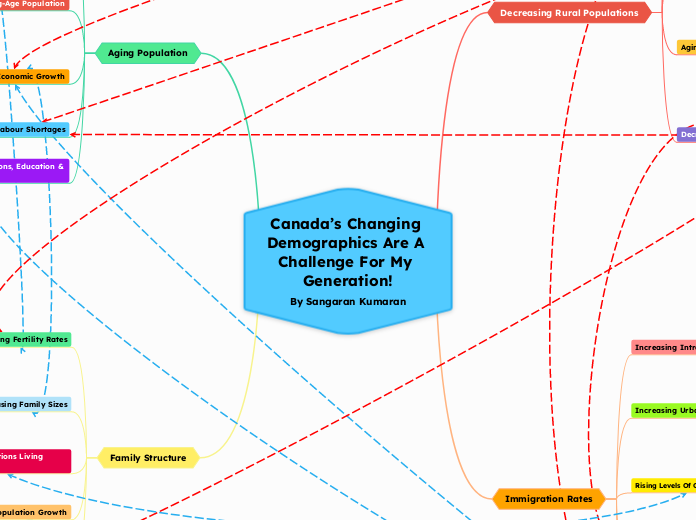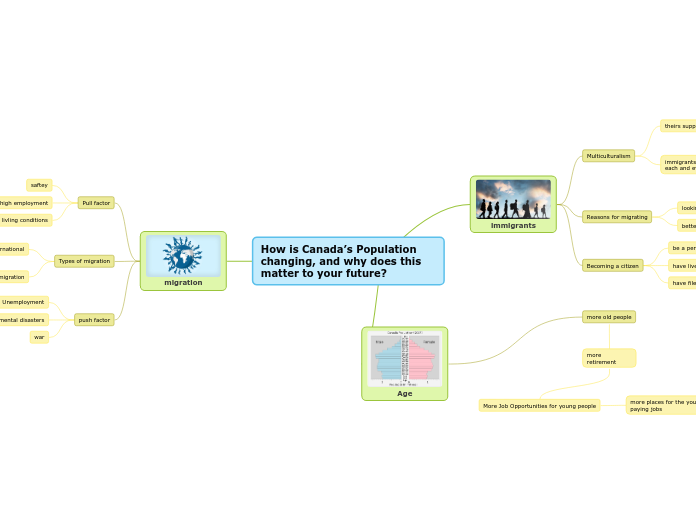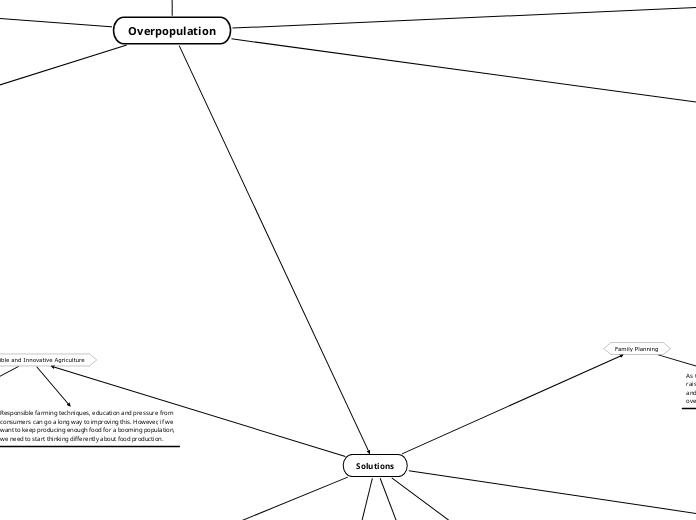Canada’s Changing Demographics Are A Challenge For My Generation!
By Sangaran Kumaran
Family Structure
Decreasing Literacy Rates & Education Attendants
Explanation: With fewer people being born and the price of education rising, fewer individuals attend education, resulting in a lower literacy rate.
Statistics Canada reported on tuition fees that show the average yearly cost for Canadian undergraduates has increased to $7,076.
Up 2.9% from the 2022-23 school year
Since 2018, a report has revealed a troubling decline in children's literacy.
Declining Population Growth
Explanation: With women having fewer births in Canada, the population is declining.
According to officials, without immigration in Canada, the population would decrease rapidly due to low birth rates, fertility rates and an aging population.
StatsCan reports that Canada's 2022 fertility rate was the lowest in record.
Mulitple Families & Generations Living Under One Roof
Explanation: With prices skyrocketing in Canada and decreasing fertility rates, Canadians have resorted to living with multiple families/generations under one roof.
According to Rob Golfi, the number of intergenerational households is increasing in Canada, such as in Toronto and Vancouver.
The number is growing at a rapid pace
Decreasing Family Sizes
Explanation: With lower fertility rates in Canada, there will be smaller sizes of families compared to before.
Between 2010 and 2021, the average household size decreased by 3.1%.
Canada had an average household size of 2.51 people in 2021 and recorded a year-on-year decline of 0.8% in 2021.
Decreasing Fertility Rates
Explanation: With life in Canada becoming a daily expensive challenge, couples are deciding to have fewer children than couples did in the previous decades, decreasing the fertility rate.
2024 Fertility Rate: 1.483 births per women
0.07% decline from 2023
Canada experienced a 7.4% decline in fertility from 2021 to 2022.
A drastic decline in a year
Aging Population
Decreasing Funds For Pensions, Education & Healthcare
Explanation: With fewer workers to contribute to the Canadian economy, there will be fewer funds from the government going towards pensions, education, healthcare, etc.
According to officials, the funds for each student in the 2023-2024 school year will be $1,200 less than the 2018-2019 school year.
Increasing Labour Shortages
Explanation: An aging population and decreasing working-age population will create increased labour shortages throughout Canada.
According to officials, Canada faces a significant labour shortage, with almost a million job vacancies recorded in February 2023.
Declining Economic Growth
Explanation: With an aging population, increasing age dependency ratio and decreasing working-age population, there will be less people to contribute to the economy of Canada.
Economic Growth in Canada went from 1.1% in 2023 to 0.9% in 2024.
On a declining rate
According to the Royal Bank of Canada, the Canadian economy is still slowing as the weakened impact of increasing interest rates sets.
Decreasing Working-Age Population
Explanation: With an increasing age dependency ratio, there will be a shrinking working-age population in Canada.
Employed Working-Age Population Ratio: 61.6% (January 2024)
According to Statistics Canada, the employed working-age population in Canada is declining for the fourth consecutive month.
After rising at 69.5% in 2007, the ratio of the population aged 15 to 64 years declined steadily until 2022, to 65.5%.
Increasing Dependency Load
Explanation: With an aging population and more dependent elders being added to the population, our country's dependency load will increase.
The number for the age dependency ratio in Canada is projected to be on the rise.
2024 Age Dependency Ratio: 52.1% of the population
28.2% of the population is elders
By 2038, there will be more elders than youth in Canada’s population.
Immigration Rates
Rising Inaccessibility Rates
Explanation: Due to more immigrants arriving in Canada and boosting local populations, it would result in limited supplies of cities being used quickly and selectively by a large population, leading to the inaccessibility of goods and resources to some individuals.
15% of Canadians are pleased with access to care, while 29% of Americans are pleased with access.
Results of a Healthcare Poll
Increasing Interprovincial Rates
Explanation: Due to Canada receiving more immigrants, places in Canada are becoming more crowded and challenging to live in, resulting in individuals migrating to other cities in different provinces or territories to seek new and better opportunities.
According to the CBC, new data shows a record stretch of people leaving B.C. for other provinces, with many heading to Alberta.
Alberta has the highest interprovincial migratory increase.
2024 Statistic
Rising Levels Of Overpopulated Cities
Explanation: The patterns of immigration in Canada showcase that immigrants are living in the same regions that other immigrants do, boosting the local population and resulting in overcrowding in that area.
Canadian cities are becoming densely populated at an alarming rate.
Canada's largest metropolitan area is Toronto, Ontario, with over 6.6 million people living there in 2022.
Increasing Urbanization
Explanation: With more immigrants arriving in Canada, more things need to be built, such as housing and infrastructure, resulting in the urbanization of the community, area or city.
Over 80% of Canadians live in urban centers.
The urbanization rate in Canada increased by 10% on a year-on-year basis in 2021.
More than 90% of immigrants settled in Census Metropolitan Areas (CMAs).
One of the reasons for the drastic increase in urbanization in Canada is immigration.
Increasing Intraprovincial Rates
Explanation: Due to Canada receiving more immigrants, places in Canada are becoming more crowded and challenging to live in, resulting in individuals migrating to other cities in the same province or territory to seek new and better opportunities.
The 2011 census reported that about 11% of Canadians (3.4 million people) had moved within their province in the preceding five years.
Decreasing Rural Populations
Decreasing Income & Employment
Explanation: With fewer job opportunities in rural areas compared to urban areas, the average income of a person in rural areas is decreasing alongside decreasing employment levels.
Unemployment levels tend to be higher compared to urban areas.
Rural incomes are behind those of urban communities.
Almost 20% of the population in Canada lives in rural, remote, Indigenous, coastal, or northern communities.
These communities contribute to the economic output of Canada by only about 30%.
Aging Infrastructure
Explanation: With fewer people in rural areas, there will be less supervision, management and care for the infrastructure, resulting in the infrastructure rotting and aging.
Aging infrastructure, competing priorities and limited budgets are challenges municipalities encounter in making infrastructure decisions.
Governments of rural areas face challenges in providing the infrastructure that’s needed to build the communities of the future.
300,000 low-income households facing housing affordability challenges
Rising Food Scarcity/Inaccessibility To Food Levels
Explanation: With rising food prices and declining supply in the market, fewer Canadians will be able to afford food at these prices, resulting in higher levels of food scarcity and inaccessibility to food.
Data from the 2019 Survey of Financial Security reveal that in 2022, 18% of Canadian families reported experiencing food insecurity in the past year.
At least 15.9% of households (5.8 million people) across Canada's provinces were living with insecure or insufficient access to food in 2021.
This number was up from 16% in 2021.
Rising Food Prices
Explanation: With fewer people working in the agricultural industry, the supply of organic foods will lower while the demand for them will increase, resulting in higher food prices.
According to officials, food prices will probably rise by 2.5% to 4.5% in 2024.
Compared to 5% to 7% in 2023
Decreasing Agricultural Practices & Industries
Explanation: A decrease in rural populations will cause a decline in the agricultural industry as fewer people will practice agriculture and work on farms.
Employment in the agriculture industry increased merely by 2.4% in 2022, after declining by 6.1% in 2021.
Agriculture only makes up about 1.2% of Ontario's total GDP.









